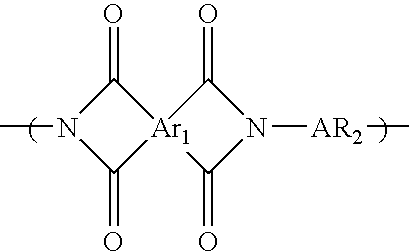Water-soluble polyimide precursor, aqueous polyimide precursor solution, polyimide, impregnated material with polyimide binder, and laminate
a technology of water-soluble polyimide and precursor solution, which is applied in the direction of synthetic resin layered products, textiles and paper, woven fabrics, etc., can solve the problems of poor solubility of most fully aromatic polyimides in organic solvents, limited use of polyimide powders, and poor solubility of most fully aromatic polyimides
- Summary
- Abstract
- Description
- Claims
- Application Information
AI Technical Summary
Benefits of technology
Problems solved by technology
Method used
Image
Examples
example 1
[0090] After adding 29.23 g (0.1 mol) of TPE-R and 234.60 g of DMAc into a 1000 ml 4-necked separable flask equipped with a stirrer, a reflux condenser (with moisture separator), a thermometer and a nitrogen inlet tube at room temperature, 29.42 g (0.1 mol) of a-BPDA was added to the mixed solution, while stirring under a nitrogen gas stream, and reaction was carried out for 2 hours to obtain a polyimide precursor solution.
[0091] The solution was then diluted with 293.25 g of DMAc to a viscosity of 1.5 poise at 30° C. After next adding 5.87 g (0.06 mol) of DMZ to the solution, it was slowly added to acetone (6.5 L) in a homogenizer (OMNIMIXER LT by Yamato Chemical Co., Ltd.) for precipitation of the polyimide precursor powder. The suspension was filtered and subjected to acetone washing and vacuum dried at 40° C. for 10 hours to obtain 63.42 g of polyimide precursor powder.
[0092] After adding 26.10 g of water and 0.9 g (0.0094 mol) of DMZ to 3 g of the polyimide precursor powder (...
example 2
[0095] After adding 29.42 g (0.1 mol) of a-BPDA and 637.86 g of acetone into a 2000 ml 4-necked separable flask equipped with a stirrer, a reflux condenser (with moisture separator), a thermometer and a nitrogen inlet tube and dissolving at room temperature, a solution of 29.23 g (0.1 mol) of TPE-R dissolved in 200 g of acetone was added over a period of one minute, and a reaction was carried out for 2 hours to complete precipitation of the polyimide precursor. Next, 5.87 g (0.06 mol) of DMZ was added to this suspension, and stirring was continued for one hour. The suspension was then filtered, washed with acetone and vacuum dried at 40° C. for 10 hours to obtain 63.16 g of polyimide precursor powder.
[0096] After adding 18.1 g of water and 0.6 g (0.0062 mol) of DMZ to 3 g of this polyimide precursor powder (total DMZ / COOH=1.0 mol. eq.), a polyimide precursor aqueous solution and polyimide film were obtained in the same manner as Example 1.
[0097] The polyimide film exhibited satisf...
example 3
[0098] After adding 15.8 g of water and 1.2 g (0.012 mol) of DMZ to 3 g of polyimide precursor powder (total DMZ / COOH=1.6 mol. eq.) separated from the acetone solution of Example 2, a polyimide precursor aqueous solution and polyimide film were obtained in the same manner as Example 2.
[0099] The polyimide film exhibited satisfactory thermal and mechanical properties. The results are summarized in Table 1.
PUM
| Property | Measurement | Unit |
|---|---|---|
| decomposition temperature | aaaaa | aaaaa |
| glass transition temperature | aaaaa | aaaaa |
| breaking elongation | aaaaa | aaaaa |
Abstract
Description
Claims
Application Information
 Login to View More
Login to View More - R&D
- Intellectual Property
- Life Sciences
- Materials
- Tech Scout
- Unparalleled Data Quality
- Higher Quality Content
- 60% Fewer Hallucinations
Browse by: Latest US Patents, China's latest patents, Technical Efficacy Thesaurus, Application Domain, Technology Topic, Popular Technical Reports.
© 2025 PatSnap. All rights reserved.Legal|Privacy policy|Modern Slavery Act Transparency Statement|Sitemap|About US| Contact US: help@patsnap.com

